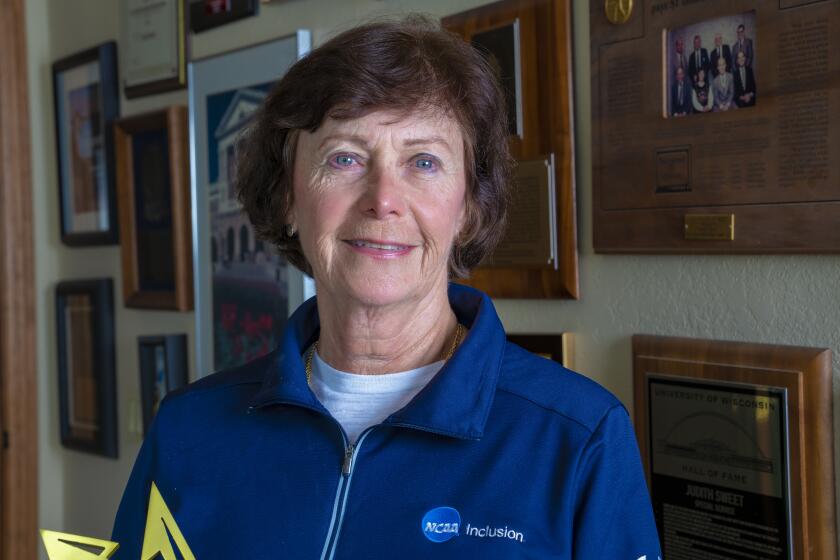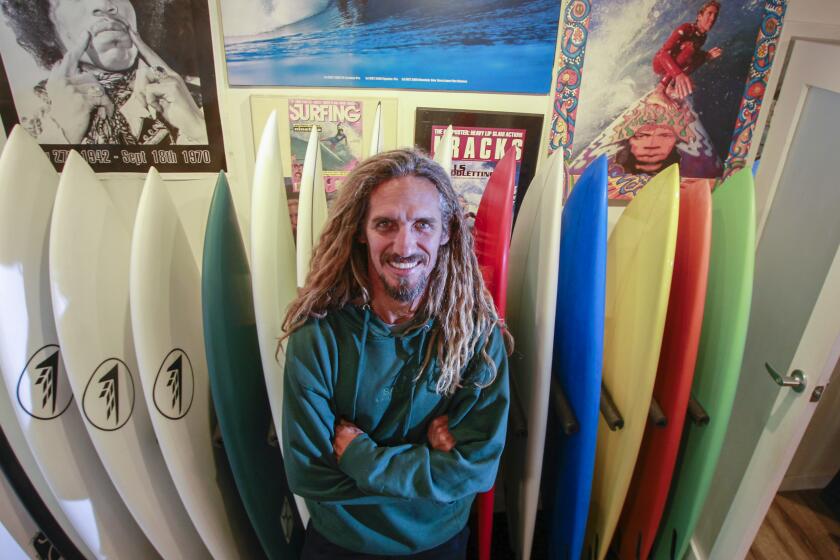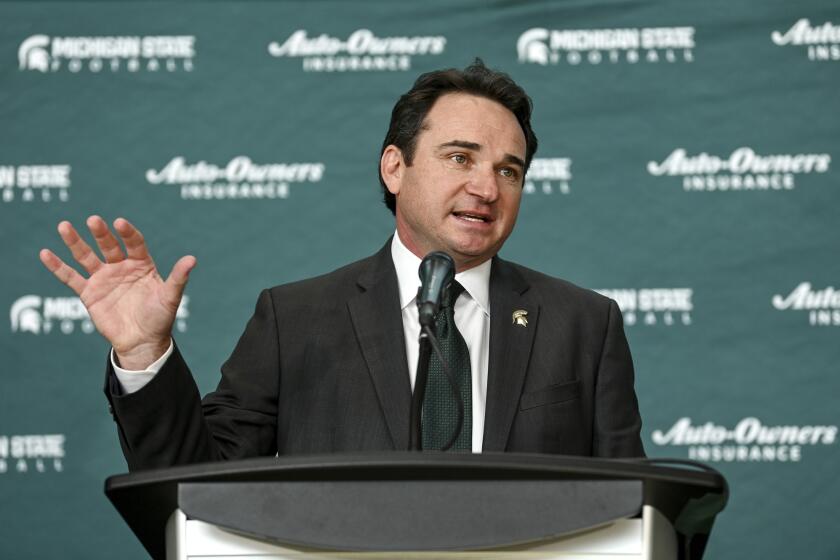San Diegan builds spectacular Danzante Bay golf course in Loreto, Mexico
He was a kid from Rhode Island, the son of a career Navy man, and had never been to a tropical locale in his life. Vacations consisted of loading up the family station wagon for a trip to grandma’s house.
Owen Perry didn’t know anything about Hawaii, tourism or the timeshare business when he moved to Honolulu and dived in as a 20-year-old with $700 in his bank account.
“That’s when the boy became a man,” Perry said with a smile, over lunch recently in a posh Rancho Santa Fe restaurant. “I had to outlast them, and that toughness taught me how to survive.”
Success in Hawaii led to the enormous gamble of going to Mexico in the mid-1980s to sell timeshares, even if Perry didn’t speak a word of Spanish. He loved the country and its opportunities so much that he never left.
Now splitting time with his family of four between estates in Cabo San Lucas and Rancho Santa Fe, Perry and his Villa Group own and operate 12 luxury resort properties in Cabo, Puerto Vallarta, Cancun, Nayarit and Loreto.
It’s in Loreto – the village of 14,000 on Baja California Sur’s eastern coast -- that Perry is making his first foray into the golf business. As with every other part of his work, he went all in.
Perry hired architect Rees Jones to design Danzante Bay to complement his Villa del Palmar Resort & Spa, and in the first Mexican project for the “Open Doctor,” they created a desert-to-ocean course on the Sea of Cortez that is getting rave reviews worldwide.
The course features a par-3 hole perched on the edge of the cliffs that looks like something on one of those fantasy golf calendars, and it already has made the cover of the magazine published by the Royal & Ancient Golf Club.
Perry was walking his dog one day when his phone rang. It was Jones, who’d never made the cover with any of his 230 courses.
“We’re famous!” he told Perry.
At a cost of $10 million to build, Danzante Bay opened with 11 holes in April 2016, mostly because Perry said guests were eager to get out to experience it. The final seven holes are now complete — they were worth the wait — and the full course opened for play in late November.
“To get a site like this, it’s pretty exciting,” Jones said in an interview.
There are few landscapes in the world that offer this kind of palette.
From the blue-green Sea of Cortez, where the horizon is dotted with the nearby islands of Loreto, the land rises almost immediately into what becomes the “La Giganta” mountain range – Baja’s Sierra Nevada.
There are cathedrals of red rock that are reminiscent of Sedona, Ariz., some cactus and desert landscape that recall the Coachella Valley, and other views on the course can make it seem like golfers have been airlifted to the floor of the Grand Canyon.
There’s the par-3 17th set on a cliff, 250 feet above the water, but also another par-3 — the 13th — with a green placed only a few yards from the beach and water’s edge.
“The site really directed us,” Jones said. “You could see where each hole would go. It was just the perfect site for natural golf.”
Perry watched his friends develop golf courses in Cabo and was dismayed by seeing former big-name players hired to do a design, fly in a couple of times on their private jets and not come back until the ribbon-cutting ceremony.
“I wanted to build a great golf course, and in order to do that, I wanted a great architect – not a celebrity golfer,” Perry said. “I felt very comfortable with that decision, and I think it turned out well.”
The desire by Perry, and Jones agreed, was to produce a fun and playable course that would appeal to all levels of golfers. Too many courses, Perry believed, are built to stroke the owner’s ego rather than the golfer’s enjoyment. Perry started golf at middle age himself, first taking up the game while living near Del Mar Country Club.
Jones, with design associate Steve Weisser on the ground for the construction, delivered with ample driving areas and subtle contouring on the greens. There are five sets of tees, with the black positioned at 7,237 yards, followed by gold (6,595), blue (6,141), white (5,651) and red (4,916). The green fees are $175.
The 17th hole wasn’t in the original plans. Jones and Weisser hiked to the top of a ridge one day and saw a ledge over the ocean.
Could they possibly put a hole there?
“We asked Owen about it, and he said, ‘Sure!’” Jones recalled.
Jones believes the 17th — playing 149 yards from the blues, 140 from the whites — will be among the notable holes of his career, just as the famous ocean par-3 at Mauna Kea on Hawaii’s Big Island is among the most renowned designed by his father, Robert Trent Jones Sr.
“I don’t want to build it up too much,” Jones said. “But I think this is going to be a worldwide famous hole. I think to some degree it already is.”
The hole and the course may put Loreto on the map, too.
The village, with its colorful colonial buildings, sidewalk cafes and tree-lined streets, has been known mostly for its mission – the first founded in the Californias in 1697 – and as a sportfishing launch base. Perry became enamored of it on a side trip years ago and saw its potential.
The problem was that, despite being a designated Mexican tourist city, well situated on Highway 1 and with an international airport, Loreto got little travel buzz. Perry said that when he began development of the resort eight years ago, Alaska Airlines was flying there from Los Angeles once a week and was preparing to halt service altogether.
Perry took action, contracting with Carlsbad-based Cal Jet to run charters from Los Angeles. He enticed travelers with sweet flight and room deals, and people started to come. Now, Alaska has direct, two-hour flights from LAX four days a week, while San Diegans can fly direct from Tijuana on Calafia Airlines, three days a week.
Earlier this year, Mexican tourism was flourishing. The country’s tourism board reported an 11.8 percent increase, or 6.7 million more U.S. visitors, from January through July 2017.
However, that enthusiasm may have been dampened late in the summer by the U.S. State Department’s travel warning that cited increased homicide rates, mostly due to drug-related violence, in the resort states of Quintana Roo and Baja California Sur.
Perry said that while headlines scare people, they don’t match his opinion that tourists should feel no more ill at ease than they are visiting other international cities.
A study released this year concluded that an average of 10 million Americans per year visited Mexico between 2009 and 2016, and 58 per year were killed by violence. That’s a homicide rate of .0000058 percent.
“The people who know Mexico are coming,” Perry said. “The people who read the headlines are afraid. I’ve been here 35 years and have never seen any violence.”
Golf continues to boost Mexican tourism. According to the R&A, there were 237 golf courses in Mexico as of 2015. Some of the best are on the Baja Sur coastline, with signatures on them from the likes of Jack Nicklaus, Greg Norman, Tiger Woods and Davis Love III.
There are 16 courses in Cabo San Lucas, with more being planned.
“What changed the dynamics for Cabo wasn’t fishing,” Perry said. “It was golf.”
Seeing what golf did for Cabo, Perry built Danzante Bay to attract tourists and American buyers for the 140 luxury homes he plans to build. The only other golf course in Loreto — a David Duval design called Loreto Bay — is attached to another resort not owned by Perry.
Time will tell how much Loreto grows, but like so many other projects he’s done, Perry is giving it his full energy and attention.
“I have a very good reputation and I’ve been in the Baja a long time,” Perry said. “I’ve been fortunate that there aren’t a lot of Americans down there like me, and the less people you have, the more opportunity you have.
“This is really where I want to focus the rest of my career. My gosh, I really think the Baja has a huge future.”
Sports Videos
Go deeper inside the Padres
Get our free Padres Daily newsletter, free to your inbox every day of the season.
You may occasionally receive promotional content from the San Diego Union-Tribune.









